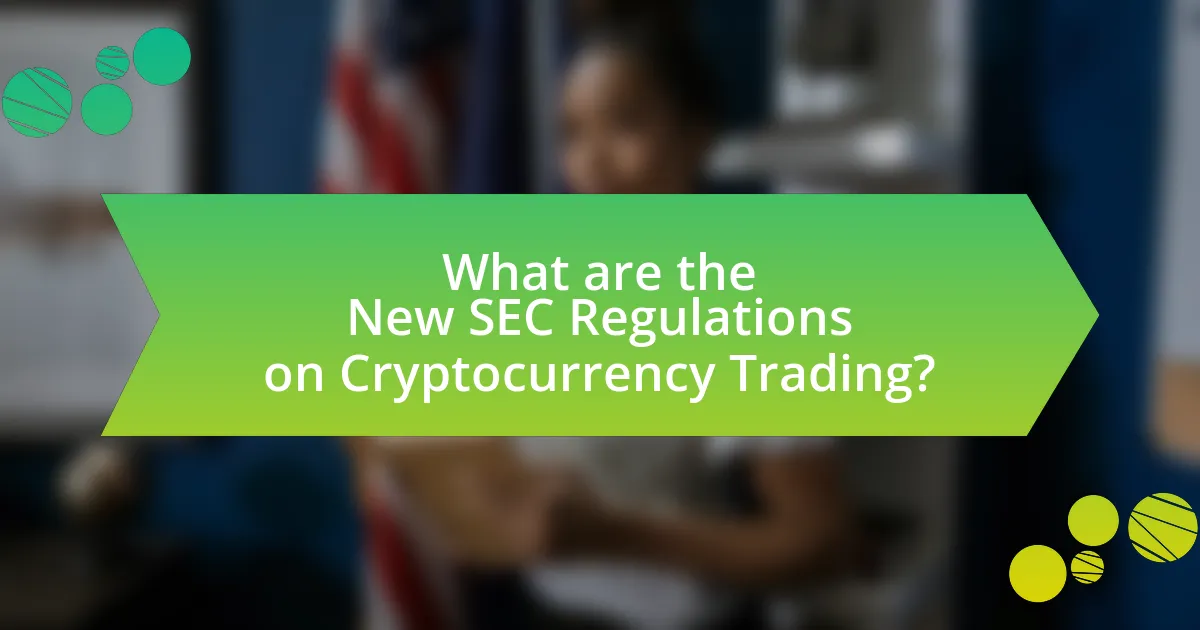The article analyzes the new regulations introduced by the U.S. Securities and Exchange Commission (SEC) regarding cryptocurrency trading, which aim to enhance investor protection and market transparency. Key aspects include the requirement for cryptocurrency exchanges to register with the SEC, adhere to strict reporting standards, and implement measures to prevent fraud and manipulation. The article discusses the implications of these regulations for exchanges and investors, detailing compliance requirements such as Know Your Customer (KYC) and Anti-Money Laundering (AML) protocols, as well as the potential risks and challenges posed by increased regulatory scrutiny. Additionally, it highlights the SEC’s motivations for these regulations, including the need to address market volatility and fraudulent activities within the cryptocurrency landscape.

What are the New SEC Regulations on Cryptocurrency Trading?
The new SEC regulations on cryptocurrency trading primarily focus on enhancing investor protection and increasing market transparency. These regulations require cryptocurrency exchanges to register with the SEC, adhere to strict reporting requirements, and implement measures to prevent fraud and manipulation. Additionally, the SEC has clarified that many cryptocurrencies qualify as securities, thus subjecting them to existing securities laws. This regulatory framework aims to create a safer trading environment and ensure compliance with federal securities laws, as evidenced by the SEC’s increased enforcement actions against unregistered offerings and exchanges in recent years.
How do these regulations impact cryptocurrency exchanges?
Regulations significantly impact cryptocurrency exchanges by imposing compliance requirements that affect their operational frameworks. These regulations often mandate that exchanges implement Know Your Customer (KYC) and Anti-Money Laundering (AML) protocols, which can increase operational costs and complexity. For instance, the SEC’s focus on investor protection and market integrity has led to stricter reporting and disclosure obligations for exchanges, compelling them to enhance their transparency and security measures. As a result, exchanges may face challenges in adapting to these regulatory demands, which can influence their market competitiveness and user trust.
What specific requirements must exchanges comply with under the new regulations?
Exchanges must comply with several specific requirements under the new SEC regulations, including registration as a national securities exchange or an alternative trading system, implementing robust anti-money laundering (AML) and know your customer (KYC) protocols, and ensuring transparency in their operations. These regulations aim to enhance investor protection and market integrity. For instance, the SEC mandates that exchanges must provide detailed disclosures about their trading practices and maintain adequate cybersecurity measures to protect user data and assets.
How do these requirements enhance consumer protection?
The requirements enhance consumer protection by establishing clear guidelines for cryptocurrency trading platforms, ensuring transparency and accountability. These regulations mandate that platforms disclose risks associated with trading, thereby informing consumers about potential losses. Additionally, the requirements include measures for safeguarding consumer funds, such as maintaining adequate reserves and implementing security protocols to prevent fraud. By enforcing these standards, the SEC aims to reduce the likelihood of scams and protect investors from misleading practices, ultimately fostering a safer trading environment.
What are the implications for cryptocurrency investors?
The implications for cryptocurrency investors include increased regulatory scrutiny and potential changes in trading practices. The new SEC regulations aim to enhance investor protection and market integrity, which may lead to stricter compliance requirements for exchanges and issuers. For instance, the SEC’s focus on classifying certain cryptocurrencies as securities could result in additional reporting obligations and oversight, impacting how investors trade and hold these assets. Historical data shows that regulatory announcements often lead to market volatility; for example, after the SEC’s 2018 guidance on ICOs, many projects faced significant operational changes or ceased operations altogether. Therefore, investors must stay informed about regulatory developments to navigate the evolving landscape effectively.
How will the new regulations affect trading practices for individual investors?
The new regulations will impose stricter compliance requirements on trading practices for individual investors. These regulations aim to enhance transparency and reduce market manipulation, which may lead to increased costs for individual investors due to the need for more rigorous reporting and compliance measures. For instance, the SEC’s focus on anti-fraud provisions and the requirement for clearer disclosures will necessitate that individual investors adapt their trading strategies to align with these new standards, potentially limiting their trading options and increasing the complexity of transactions.
What risks do investors face under the new regulatory framework?
Investors face several risks under the new regulatory framework established by the SEC for cryptocurrency trading, including increased compliance costs, potential market volatility, and regulatory uncertainty. Increased compliance costs arise as firms must invest in systems and processes to adhere to new regulations, which can reduce profit margins. Market volatility may be exacerbated by regulatory changes, as sudden announcements or enforcement actions can lead to sharp price fluctuations in cryptocurrencies. Additionally, regulatory uncertainty can create an unpredictable environment, making it difficult for investors to assess the long-term viability of their investments. These risks are underscored by the SEC’s historical enforcement actions, which have led to significant market reactions and investor losses in the past.

Why were these regulations introduced?
These regulations were introduced to enhance investor protection and ensure market integrity in the rapidly evolving cryptocurrency trading landscape. The U.S. Securities and Exchange Commission (SEC) recognized the need for regulatory oversight due to the increasing prevalence of fraud, market manipulation, and the lack of transparency in cryptocurrency markets. Historical instances of significant financial losses among investors, such as the collapse of major cryptocurrency exchanges, underscored the urgency for regulatory measures. By implementing these regulations, the SEC aims to create a safer trading environment, promote fair practices, and foster confidence among investors in the cryptocurrency sector.
What events or trends prompted the SEC to act?
The SEC acted in response to significant events and trends in the cryptocurrency market, particularly the surge in Initial Coin Offerings (ICOs) and the rise of fraudulent schemes. The rapid increase in ICOs, which raised over $5 billion in 2017 alone, led to concerns about investor protection and market integrity. Additionally, high-profile cases of fraud, such as the BitConnect Ponzi scheme, highlighted the need for regulatory oversight. These factors prompted the SEC to implement regulations aimed at ensuring transparency and safeguarding investors in the evolving cryptocurrency landscape.
How have previous regulatory failures influenced the current regulations?
Previous regulatory failures have significantly shaped current regulations by highlighting the need for stricter oversight and clearer guidelines. For instance, the collapse of major cryptocurrency exchanges, such as Mt. Gox in 2014, exposed vulnerabilities in the market, leading to increased calls for regulatory frameworks that protect investors and ensure market integrity. In response, the SEC has implemented regulations that require greater transparency from cryptocurrency firms, including mandatory disclosures and compliance with anti-money laundering laws. These measures aim to prevent similar failures by addressing the systemic risks identified in past incidents, thereby fostering a more secure trading environment.
What role do market volatility and fraud play in the SEC’s decision?
Market volatility and fraud significantly influence the SEC’s decision-making process regarding cryptocurrency regulations. The SEC considers market volatility as a risk factor that can lead to investor losses and market manipulation, prompting the need for regulatory measures to protect investors. For instance, the SEC has observed that extreme price fluctuations in cryptocurrencies can create an environment ripe for fraudulent activities, such as pump-and-dump schemes. In response, the SEC has implemented regulations aimed at increasing transparency and accountability in the cryptocurrency market to mitigate these risks. This approach is supported by historical instances where lack of regulation has led to substantial financial losses for investors, reinforcing the SEC’s mandate to safeguard market integrity.
What are the goals of the new SEC regulations?
The goals of the new SEC regulations are to enhance investor protection, promote market integrity, and ensure compliance within the cryptocurrency trading landscape. These regulations aim to address the risks associated with fraud and manipulation in digital asset markets, as evidenced by the increasing number of enforcement actions taken by the SEC against non-compliant entities. By establishing clear guidelines, the SEC seeks to foster a safer trading environment and encourage responsible innovation in the cryptocurrency sector.
How do these regulations aim to stabilize the cryptocurrency market?
Regulations aim to stabilize the cryptocurrency market by implementing strict compliance measures that enhance transparency and reduce fraud. These regulations require cryptocurrency exchanges and issuers to adhere to specific reporting standards, which helps to build investor trust and mitigate the risks associated with market manipulation. For instance, the SEC’s enforcement actions against fraudulent Initial Coin Offerings (ICOs) have led to a decrease in scams, thereby fostering a more secure trading environment. Additionally, the introduction of Know Your Customer (KYC) and Anti-Money Laundering (AML) requirements further ensures that only legitimate participants engage in trading, contributing to overall market stability.
What measures are in place to prevent market manipulation?
The measures in place to prevent market manipulation include stringent regulations enforced by the Securities and Exchange Commission (SEC), which require transparency in trading practices and impose penalties for fraudulent activities. These regulations mandate that exchanges implement surveillance systems to detect suspicious trading patterns and report them to the SEC. Additionally, the SEC has established rules that prohibit practices such as insider trading and pump-and-dump schemes, which are designed to manipulate market prices. Historical enforcement actions, such as the SEC’s crackdown on fraudulent Initial Coin Offerings (ICOs), demonstrate the agency’s commitment to maintaining market integrity and protecting investors from manipulation.

How will the new SEC regulations be enforced?
The new SEC regulations will be enforced through a combination of increased surveillance, compliance requirements, and penalties for violations. The SEC will utilize advanced technology and data analytics to monitor trading activities and identify potential non-compliance. Additionally, firms involved in cryptocurrency trading will be required to adhere to strict reporting and disclosure standards, ensuring transparency in their operations. Non-compliance can result in significant fines and legal actions, as evidenced by past enforcement actions where the SEC has imposed penalties on companies for failing to register securities offerings or misleading investors.
What mechanisms are in place for monitoring compliance?
The mechanisms in place for monitoring compliance with the new SEC regulations on cryptocurrency trading include regular audits, reporting requirements, and surveillance systems. These mechanisms ensure that trading platforms adhere to regulatory standards by conducting periodic assessments of their operations, requiring them to submit detailed reports on transactions and activities, and utilizing advanced technology to monitor trading patterns for suspicious behavior. For instance, the SEC mandates that exchanges implement robust compliance programs that include transaction monitoring and risk assessment protocols, which are essential for detecting and preventing fraudulent activities.
How will the SEC handle violations of the new regulations?
The SEC will handle violations of the new regulations through enforcement actions, which may include investigations, fines, and penalties against individuals or entities that fail to comply. The SEC has a history of taking legal action against violators, as seen in past cases where it imposed significant fines for non-compliance with securities laws. For instance, in 2021, the SEC charged a cryptocurrency company with fraud, resulting in a $1.2 million penalty, demonstrating its commitment to enforcing regulations in the cryptocurrency space.
What penalties can be expected for non-compliance?
Penalties for non-compliance with the new SEC regulations on cryptocurrency trading can include substantial fines, sanctions, and potential criminal charges. The SEC has the authority to impose civil penalties that can reach up to $1 million per violation, depending on the severity and nature of the non-compliance. Additionally, individuals may face criminal prosecution, which can result in imprisonment for up to 20 years for severe violations, such as fraud or manipulation. These penalties are designed to enforce compliance and protect investors, as evidenced by the SEC’s increased enforcement actions in recent years, which have led to significant financial repercussions for non-compliant entities.
What challenges might arise during the enforcement of these regulations?
Challenges during the enforcement of new SEC regulations on cryptocurrency trading include the rapid evolution of technology, which can outpace regulatory frameworks. The decentralized nature of cryptocurrencies complicates jurisdictional authority, making it difficult for regulators to monitor and enforce compliance effectively. Additionally, the lack of standardized practices across various platforms creates inconsistencies in adherence to regulations. Historical instances, such as the SEC’s struggle to regulate initial coin offerings (ICOs) in 2017, illustrate the difficulties faced in adapting to new market dynamics. Furthermore, the potential for legal challenges from industry participants can hinder enforcement efforts, as seen in cases where companies contest regulatory actions.
How might exchanges adapt to meet compliance requirements?
Exchanges might adapt to meet compliance requirements by implementing robust Know Your Customer (KYC) and Anti-Money Laundering (AML) protocols. These measures ensure that exchanges verify the identities of their users and monitor transactions for suspicious activity, aligning with regulatory expectations set forth by the SEC. For instance, in 2021, the Financial Crimes Enforcement Network (FinCEN) emphasized the importance of these protocols, leading many exchanges to enhance their compliance frameworks. Additionally, exchanges may invest in advanced technology, such as blockchain analytics tools, to improve transaction monitoring and reporting capabilities, thereby ensuring adherence to evolving regulations.
What potential loopholes could be exploited by bad actors?
Bad actors could exploit regulatory ambiguities and gaps in the new SEC regulations on cryptocurrency trading. For instance, the lack of clear definitions for certain digital assets may allow individuals to classify tokens in ways that circumvent regulatory scrutiny. Additionally, the regulations may not adequately address decentralized finance (DeFi) platforms, enabling bad actors to operate without oversight. Historical examples include the 2017 ICO boom, where many projects took advantage of vague regulations to raise funds without proper disclosures, leading to significant investor losses. These loopholes highlight the need for more comprehensive regulatory frameworks to prevent exploitation.
What best practices should cryptocurrency traders follow under the new regulations?
Cryptocurrency traders should prioritize compliance with regulatory requirements, including accurate reporting of transactions and adherence to anti-money laundering (AML) and know your customer (KYC) protocols. These practices are essential as the new SEC regulations mandate transparency and accountability in trading activities. For instance, the SEC’s focus on preventing market manipulation and protecting investors necessitates that traders maintain detailed records of their trades and ensure that they are not engaging in fraudulent activities. By following these best practices, traders can mitigate legal risks and enhance their credibility in the evolving regulatory landscape.
How can traders ensure they remain compliant with the SEC’s guidelines?
Traders can ensure compliance with the SEC’s guidelines by thoroughly understanding and adhering to the regulations set forth for cryptocurrency trading. This includes registering with the SEC if required, maintaining accurate records of all transactions, and ensuring that all communications and marketing materials are truthful and not misleading. Additionally, traders should stay updated on any changes to SEC regulations, as the agency frequently issues new guidance and rules that impact trading practices. For instance, the SEC’s Framework for “Investment Contract” Analysis of Digital Assets provides specific criteria that traders must follow to determine whether a digital asset is a security, which is crucial for compliance.
What resources are available for staying informed about regulatory changes?
To stay informed about regulatory changes, individuals and organizations can utilize several key resources. Government websites, such as the U.S. Securities and Exchange Commission (SEC) site, provide official updates and announcements regarding new regulations. Additionally, legal and financial news outlets, including Bloomberg and Reuters, regularly report on regulatory developments, offering analysis and context. Industry associations, like the Blockchain Association, also publish insights and updates relevant to cryptocurrency regulations. Furthermore, subscribing to newsletters from regulatory bodies and following relevant social media accounts can ensure timely information on changes. These resources collectively help stakeholders remain aware of evolving regulatory landscapes.






